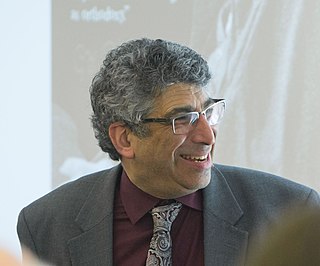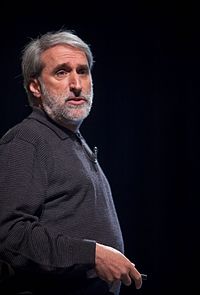A "photoelectrochemical cell" is one of two distinct classes of device. The first produces electrical energy similarly to a dye-sensitized photovoltaic cell, which meets the standard definition of a photovoltaic cell. The second is a photoelectrolytic cell, that is, a device which uses light incident on a photosensitizer, semiconductor, or aqueous metal immersed in an electrolytic solution to directly cause a chemical reaction, for example to produce hydrogen via the electrolysis of water.
Artificial photosynthesis is a chemical process that biomimics the natural process of photosynthesis. The term artificial photosynthesis is used loosely, referring to any scheme for capturing and then storing energy from sunlight by producing a fuel, specifically a solar fuel. An advantage of artificial photosynthesis would be that the solar energy could converted and stored. By contrast, using photovoltaic cells, sunlight is converted into electricity and then converted again into chemical energy for storage, with some necessary losses of energy associated with the second conversion. The byproducts of these reactions are environmentally friendly. Artificially photosynthesized fuel would be a carbon-neutral source of energy, but it has never been demonstrated in any practical sense. The economics of artificial photosynthesis are noncompetitive.

Water splitting is the chemical reaction in which water is broken down into oxygen and hydrogen:

Photosensitizers are light absorbers that alter the course of a photochemical reaction. They usually are catalysts. They can function by many mechanisms, sometimes they donate an electron to the substrate, sometimes they abstract a hydrogen atom from the substrate. At the end of this process, the photosensitizer returns to its ground state, where it remains chemically intact, poised to absorb more light. One branch of chemistry which frequently utilizes photosensitizers is polymer chemistry, using photosensitizers in reactions such as photopolymerization, photocrosslinking, and photodegradation. Photosensitizers are also used to generate prolonged excited electronic states in organic molecules with uses in photocatalysis, photon upconversion and photodynamic therapy. Generally, photosensitizers absorb electromagnetic radiation consisting of infrared radiation, visible light radiation, and ultraviolet radiation and transfer absorbed energy into neighboring molecules. This absorption of light is made possible by photosensitizers' large de-localized π-systems, which lowers the energy of HOMO and LUMO orbitals to promote photoexcitation. While many photosensitizers are organic or organometallic compounds, there are also examples of using semiconductor quantum dots as photosensitizers.
Photodissociation, photolysis, photodecomposition, or photofragmentation is a chemical reaction in which molecules of a chemical compound are broken down by absorption of light or photons. It is defined as the interaction of one or more photons with one target molecule that dissociates into two fragments.

Tris(bipyridine)ruthenium(II) chloride is the chloride salt coordination complex with the formula [Ru(bpy)3]Cl2. This polypyridine complex is a red crystalline salt obtained as the hexahydrate, although all of the properties of interest are in the cation [Ru(bpy)3]2+, which has received much attention because of its distinctive optical properties. The chlorides can be replaced with other anions, such as PF6−.
Nathan S. Lewis is the George L. Argyros Professor of Chemistry at the California Institute of Technology (Caltech). He specializes in functionalization of silicon and other semiconductor surfaces, chemical sensing using chemiresistive sensor arrays, and alternative energy and artificial photosynthesis.
Photocatalytic water splitting is a process that uses photocatalysis for the dissociation of water (H2O) into hydrogen (H
2) and oxygen (O
2). The inputs are light energy (photons), water, and a catalyst(s). The process is inspired by Photosynthesis, which converts water and carbon dioxide into oxygen and carbohydrates. Water splitting using solar radiation has not been commercialized. Photocatalytic water splitting is done by dispersing photocatalyst particles in water or depositing them on a substrate, unlike Photoelectrochemical cell, which are assembled into a cell with a photoelectrode. Hydrogen fuel production using water and light (photocatalytic water splitting), instead of petroleum, is an important renewable energy strategy.
Michelle C. Y. Chang is a Professor of Chemistry and Chemical and Biomolecular Engineering at the University of California, Berkeley, and is a recipient of several young scientist awards for her research in biosynthesis of biofuels and pharmaceuticals.
Photochemical reduction of carbon dioxide harnesses solar energy to convert CO2 into higher-energy products. Environmental interest in producing artificial systems is motivated by recognition that CO2 is a greenhouse gas. The process has not been commercialized.

Andrew Bruce Bocarsly is currently a professor at Princeton University, New Jersey. His primary research interests lie in physical inorganic chemistry. He conducts research in electrochemistry, photochemistry, solids state chemistry, and fuel cells, and is known for his work on alternate energy solutions involving processes and materials for photo-reduction and electro-reduction.
A solar fuel is a synthetic chemical fuel produced from solar energy. Solar fuels can be produced through photochemical, photobiological, and electrochemical reactions.

Photogeochemistry merges photochemistry and geochemistry into the study of light-induced chemical reactions that occur or may occur among natural components of Earth's surface. The first comprehensive review on the subject was published in 2017 by the chemist and soil scientist Timothy A Doane, but the term photogeochemistry appeared a few years earlier as a keyword in studies that described the role of light-induced mineral transformations in shaping the biogeochemistry of Earth; this indeed describes the core of photogeochemical study, although other facets may be admitted into the definition.

Jillian Lee Dempsey is an American inorganic chemist and the Bowman and Gordon Gray Distinguished Term Professor at the University of North Carolina at Chapel Hill. Currently, her work focuses on proton-coupled electron transfer, charge transfer events, and quantum dots. She is the recipient of numerous awards for rising stars of chemistry, including most recently a 2016 Alfred P. Sloan Research Fellowship and a 2016 Air Force's Young Investigator Research Program (YIP).

Water oxidation catalysis (WOC) is the acceleration (catalysis) of the conversion of water into oxygen and protons:
Jenny Yue-fon Yang is an American chemist. She is a professor of chemistry at the University of California, Irvine, where she leads a research group focused on inorganic chemistry, catalysis, and solar fuels.
The Bionic Leaf is a biomimetic system that gathers solar energy via photovoltaic cells that can be stored or used in a number of different functions. Bionic leaves can be composed of both synthetic and organic materials (bacteria), or solely made of synthetic materials. The Bionic Leaf has the potential to be implemented in communities, such as urbanized areas to provide clean air as well as providing needed clean energy.
Daniel Kwabena Dakwa Bediako is a Ghanaian-British chemist. He is currently assistant professor at the University of California, Berkeley, and is the Cupola Era Professor in the college of chemistry. His research considers charge transport and interfacial charge transfer in two-dimensional materials and heterostructures. He is also a member of the Editorial Advisory Board of the Journal of the American Chemical Society (JACS).
Villy Sundström is a Swedish physical chemist known for his work in ultrafast science and molecular photochemistry using time-resolved laser and X-ray spectroscopy techniques.
Claudia Turro is an American inorganic chemist who is the Dow Professor of Chemistry at The Ohio State University (OSU). Since July 2019 she has been the Chair of the OSU Department of Chemistry and Biochemistry. She was elected Fellow of the American Chemical Society in 2010 and is a member of the American Academy of Arts and Sciences (2023) and the National Academy of Sciences (2024).







